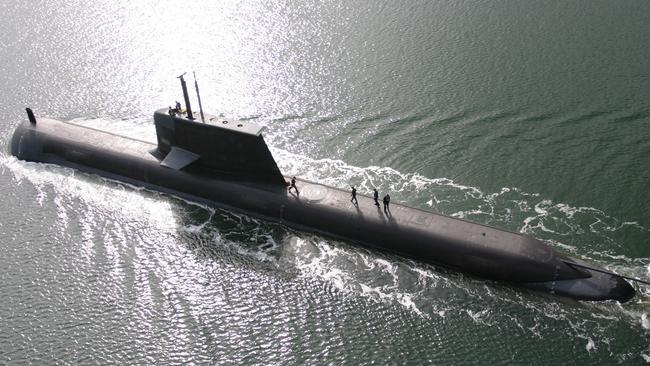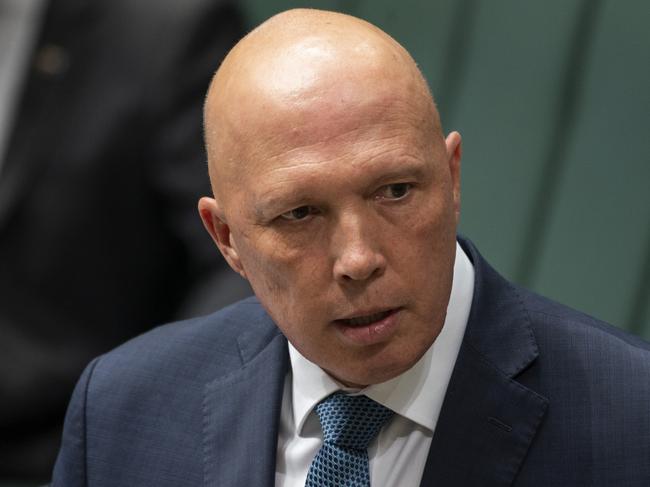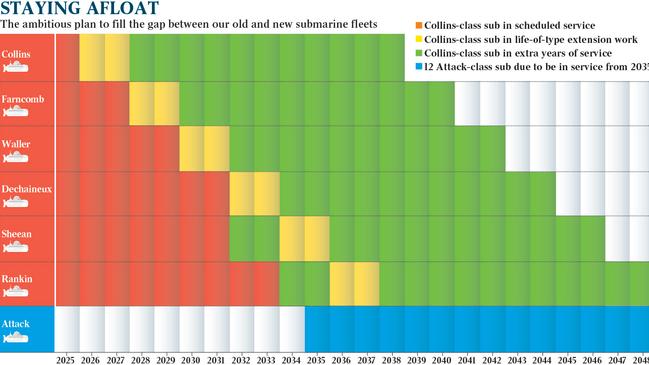$10bn refit for ageing Collins-class submarines amid China concerns
All six of the navy’s Collins-class submarines will be completely rebuilt to extend their life for another decade in the face of growing Chinese hegemony in the region.

All six of the navy’s Collins-class submarines will be completely rebuilt to extend their life for another decade, under an ambitious, high-risk plan to safeguard the nation’s submarine capability in the face of growing Chinese hegemony in the region.
Defence Minister Peter Dutton will order the whole Collins fleet to undergo the major life-of-type extension, doubling the initial Defence plan to extend just three boats, as a hedge against the fact that the first of 12 new French Attack-class submarines is not due to enter service until 2035.

The plan, which will cost up to $10bn, aims to guarantee that the submarine fleet does not fall below six boats into the future, however the slow delivery of the new French boats means the navy will not achieve its aim of having a fleet of 12 submarines until the 2050s.
“We need to be realistic about what lies ahead by way of threat in our own region and the submarine capacity is a significant part of how we mitigate that risk and it’s important we get the program right,” Mr Dutton said.
“There is no doubt in my mind that we need to pursue a life-of-type extension (for the Collins class) and we are working on that program now. All six would be on the schedule.”
The news comes ahead of a meeting in France next week between Scott Morrison and France’s President, Emmanuel Macron, where the project by French shipbuilder Naval Group to build 12 new submarines in Adelaide will be discussed.
The project has been troubled by delays and disagreements between the two countries about the level of Australian industry content and pricing.
The project is at an impasse over the price of the contract for the detailed design of the submarines, which will be a first-of-type conventional long-range submarine based partly on the design of France’s Barracuda-class nuclear-powered boats.
“Clearly there have been problems with the arrangements with Naval Group,” Mr Dutton said. “There has been concern on both sides in relation to the program and I need to make sure that we have the best capacity available to us and that contractual arrangements are being met.”
However, he said he was encouraged by the instalment of new senior Naval Group staff on the project.
“There has been a stronger engagement in the last six months than there has been before that so there are some positive signs in that regard,” Mr Dutton said.
The government was left with no choice but to extend the life of the Collins-class fleet to avoid a capability gap until the French boats enter service.
But the life-extension project is a high-risk endeavour because it will entail the complete gutting of the submarines and the replacement and upgrading of all key systems – from diesel generators, main motors and batteries to sensors, digital periscopes and other features across the entire submarine.

The first of the six Collins submarines reaches the end of its 30-year life cycle in 2026.
The planned program, known as the Collins Life of Type Extension, or LOTE, will involve rebuilding each submarine progressively once it reaches 30 years of service.
However, because the submarines were not commissioned evenly two years apart, the fifth and sixth boats, the Sheean and the Rankin, will be in service for two years longer than their 30-year life cycle even before they undergo their life-of-type expansions.
The rebuilding is scheduled to take two years for each boat.
But Defence has never attempted such a complex and complete rebuild of a submarine before and it faces a major challenge to successfully complete each boat within the two-year time frame.
If the rebuilds take longer, then the navy’s fleet of available submarines will fall below six at a time when China’s naval power in the region is growing.
Defence estimates that there are currently between 60 and 70 Chinese submarines operating in the Indo-Pacific. This number is expected to rise to at least 75 submarines by 2035.
The rebuilding of the Collins submarines is expected to be carried out by ASC in Adelaide and assisted in some form by the original builder of the boats, Sweden’s Saab Kockums.
However, no contracts have yet been signed to finalise the full extent of the work to be undertaken in the LOTE program or the degree of involvement by Saab Kockums.
“Saab is a trusted partner and they will form some part of the picture in LOTE and the extent of that is something we are contemplating at the moment,” Mr Dutton said.
“It is a tight timeline, no question about that.
“That’s why we need to make sure that Defence gets the contracting right, that our partners know that their undertakings and their commitments in the contract must be honoured and it’s important for us to get not only the timeline right but the costings right as well.”
Defence says the LOTE rebuilding will cost up to $6bn but experts say the realistic cost of such a major program will be as much as $10bn.
Faced with a tight timeline, the government has refused to rule out a so-called Plan B to give it options if the French boats are delayed or if the government chooses to walk away from the French deal altogether.
Defence Department secretary Greg Moriarty told a recent Senate estimates hearings that although the government was “absolutely committed” to building the 12 French submarines in Adelaide, “prudent contingency planning” was under way if for any reason the program could not proceed. Mr Moriarty did not say what Plan B might entail, but the most radical option would be for Australia to take a closer look at the 3400-tonne long-range submarines that Saab Kockums is proposing to build for the Dutch Navy. Mr Dutton declined to comment on a Plan B except to say: “Our focus at the moment is on the life-of-type extension for Collins, but I’ve never ruled out taking whatever decisions are necessary to make sure that we have the proper protections in place.”
Read more about the Collins and Attack-class submarines in Inquirer in The Weekend Australian tomorrow








To join the conversation, please log in. Don't have an account? Register
Join the conversation, you are commenting as Logout